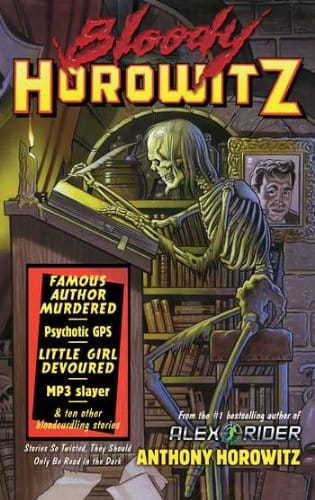Bloody Horowitz: Anthony Horowitz’s Darkly Comic Collection Revisited
Explore Anthony Horowitz’s chilling YA anthology Bloody Horowitz—plot overview, themes, style, and reading guide in one analytical review.

Introduction to Bloody Horowitz
Anthony Horowitz has long been celebrated for quick-fire plotting, razor-sharp dialogue and an unerring instinct for what thrills young readers. “Bloody Horowitz” – sometimes sold as “More Bloody Horowitz” – is his second anthology of horror stories for teens, first published in 2009. Eleven macabre tales make up the volume, each one short enough to devour in a sitting yet disturbing enough to linger long after lights-out. In an era awash with jump-scares and slasher clichés, Horowitz’s collection stands out for its wit, inventiveness and wickedly ironic twists.
Origins and Publication History
The anthology arrived more than a decade after the original “Horowitz Horror,” effectively cementing the author’s reputation as Britain’s unofficial successor to Roald Dahl’s dark short fiction for children. Written while Horowitz was also penning Alex Rider spy novels and scripting TV drama, these stories show how easily he pivots from action to terror. The title derives from the British colloquialism “bloody” – a nod to both the book’s tongue-in-cheek tone and its not-for-the-faint-hearted content. Since release, “Bloody Horowitz” has been reprinted steadily, adopted in classrooms and translated into several languages.
Story Highlights Without Major Spoilers
Each narrative opens on a recognisable adolescent scenario before taking a nightmarish turn. In “The Monkey’s Ear” a lazy student acquires a suspicious good-luck charm that grants wishes with a grotesque price tag. “The Man with the Yellow Face” pits a video-game fanatic against a sentient online avatar, while “The Lift” traps a school bully in a vertigo-inducing showdown with his own conscience. Horowitz deploys cliff-hangers, fake resolutions and last-line rug-pulls worthy of Alfred Hitchcock Presents. Readers never quite know whether justice or cruelty will triumph, and that uncertainty powers the book’s binge-ability.
Recurring Themes and Moral Undercurrents
Beneath the gore and gallows humour, the collection interrogates ethics familiar to every teenager: cheating versus hard work, loyalty versus popularity, compassion versus apathy. Characters make seemingly small choices – copying homework, telling a white lie, ignoring someone in need – that spiral into catastrophic consequences. Horowitz’s moral lens is clear but never preachy; he prefers to showcase poetic justice rather than lecture. The anthology also explores media influence, consumer culture and obsession with status, illustrating how external pressures can twist youthful judgement.
Style, Tone and Literary Influences
Horowitz writes in crisp, cinematic prose that mirrors his screenwriting background. Sentences are tight, dialogue snappy, and scenes move with TV-episode pacing. Influences range from Dahl’s “Tales of the Unexpected” to Poe’s psychological dread and classic urban legends. Yet Horowitz’s trademark irreverence ensures the scares are leavened with laugh-out-loud one-liners. This tonal elasticity makes the collection ideal for readers graduating from Goosebumps but not yet ready for Stephen King. Parents worried about extreme content can rest easy: violence is present yet stylised, and profanity is virtually nonexistent.
Characterisation and Narrative Perspective
Most protagonists are ordinary British schoolchildren: the swot yearning for social cachet, the bully hiding insecurity, the gamer escaping family stress. By anchoring horror in believable psychology, Horowitz invites empathy even as characters slide toward doom. First-person narration dominates, placing readers inside the protagonists’ panic, but occasional third-person stories offer comedic distance. Supporting casts – teachers, parents, shopkeepers – often appear larger than life, providing satirical snapshots of adult hypocrisy.
Who Should Read Bloody Horowitz?
The book targets ages 11–16, yet its brisk storytelling also captivates time-pressed adults seeking a nostalgic chill. Fans of Neil Gaiman’s darker shorts or the TV series “Creeped Out” will feel at home. Because tales are self-contained, the collection suits reluctant readers: satisfaction comes quickly, and the predictable page-count reduces intimidation. Librarians report high circulation among Key Stage 3 pupils, especially boys who may avoid longer novels.
Classroom and Book-Club Potential
Teachers frequently use “Bloody Horowitz” to introduce narrative structure, foreshadowing and unreliable narrators. A lesson might assign each group a different story to storyboard, identifying rising action and twist endings. Book-clubs can debate whether characters deserve their fates, or rewrite conclusions for alternative outcomes. The anthology also sparks discussion about digital ethics, as several plots revolve around technology gone wrong, making it a springboard for conversations on online safety.
Adaptations and Audiobook Experience
Several stories have been adapted for BBC radio, where sound design amplifies suspense through creaking doors and glitching electronics. The official audiobook, voiced by a full cast, delivers distinct accents and comedic timing that underline Horowitz’s dark humour. Screen adaptations remain unannounced, but given the current appetite for anthology horror such as “Black Mirror” and “Guillermo del Toro’s Cabinet of Curiosities,” fans hope “Bloody Horowitz” will eventually reach streaming platforms.
Final Verdict
“Bloody Horowitz” endures because it respects its audience. Anthony Horowitz neither condescends nor shields readers from life’s darker corners; instead, he hands them a flashlight and invites them to explore. Sardonic, suspenseful and surprisingly thought-provoking, the collection proves that short stories can deliver blockbuster thrills in bite-sized portions. Whether you’re a newcomer to horror or a seasoned genre devotee, these tales guarantee both goosebumps and grins — and perhaps a newfound caution the next time an offer seems too good to be true.



